I used to freeze up completely when someone died. You know that feeling – standing in the greeting card aisle, reading the same generic “deepest sympathies” over and over, knowing none of it sounds like something an actual human would say?
Quick Resource:
Turn difficult emotions into meaningful words with the Eulogy Generator.
I’ve screwed this up more times than I care to admit. But here’s what I’ve learned: the old-school approach of formal, flowery language doesn’t work anymore. People need real words from real people, not corporate-speak dressed up with roses and doves.
Research shows that the phrase “I’m sorry for your loss” gets to the point of a sympathy message, but its ubiquity can make it sound impersonal, especially when writing to someone close to you. That’s exactly why I had to figure out a better way – the old standbys weren’t cutting it anymore.
This guide shares everything I’ve discovered about writing condolence messages that actually help grieving families instead of just making you feel better about yourself.
TL;DR
- Ditch the greeting card language – grieving people can smell fake sympathy from a mile away
- Share specific memories instead of generic comfort phrases
- Your relationship with the person determines everything about your message
- Don’t assume everyone believes what you believe
- Text now, card later works for close friends; one thoughtful card is enough for everyone else
- “I’m bringing dinner Tuesday” beats “let me know if you need anything” every time
Why “Deepest Sympathies” Sounds Fake
Traditional sympathy messages followed scripts that made everyone feel awkward. The person writing them felt like they were reading from a customer service manual. The person receiving them got comfort that could have been copied and pasted from any generic card.
Here’s the thing nobody tells you: grieving people can smell fake sympathy from a mile away. They don’t need your poetry. They need you to be human.
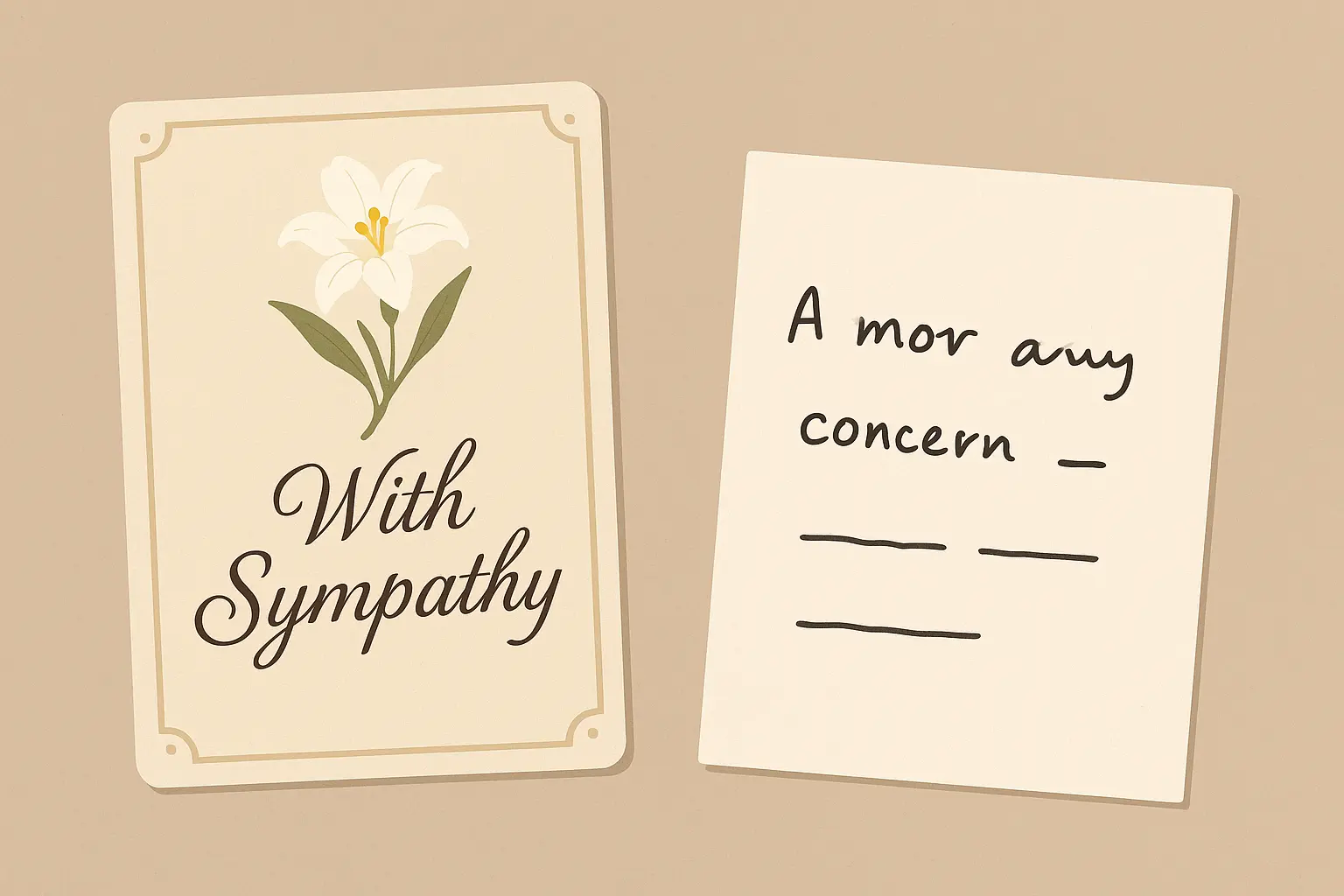
The Problem with Corporate Condolences
“Please accept my deepest sympathies during this difficult time” sounds like it came from HR. Nobody talks that way in real life. When someone you care about is hurting, you don’t walk up and say “please accept my deepest sympathies.” You say “I’m so sorry” or “this sucks” or “I can’t believe they’re gone.”
The formal approach treated death like a business transaction. You sent the appropriate card with the appropriate message, checked it off your social obligation list, and moved on. But grief isn’t a transaction – it’s messy, personal, and desperately needs real human connection.
I learned this lesson the hard way when my friend’s dad died. My first instinct was to write something safe and generic about him being “in a better place.” Then I remembered how he used to sneak extra cookies to us kids when my friend’s mom wasn’t looking, always with this mischievous grin.
That specific memory – that’s what made my friend cry (the good kind of crying). She told me later that generic messages felt like people were talking about a stranger, but the cookie story reminded her that others really knew and loved her dad too.
Why Personal Stories Beat Generic Comfort
Here’s how the transformation looks in practice:
Corporate approach: “Please accept my deepest condolences during this difficult time. Your father was a good man who will be missed.”
Human approach: “I keep thinking about how your dad always had that toolbox ready whenever any of us needed help with our cars. He never made us feel stupid for not knowing how to change oil, and he always sent us home with extra WD-40 ‘just in case.’ That generosity and patience – that was pure him.”
See the difference? One sounds like a form letter. The other sounds like you actually knew the guy.
Just as effective eulogy writing focuses on specific, personal details that honor the individual, the best sympathy messages celebrate the unique person who died rather than relying on generic expressions.
Learn how to turn memories into comforting words with the Eulogy Generator.
Digital Messages Have Rules Too
Social media and texting have created new ways to express sympathy, but they come with their own etiquette. Understanding when and how to use these platforms can help you provide comfort while respecting the family’s privacy.
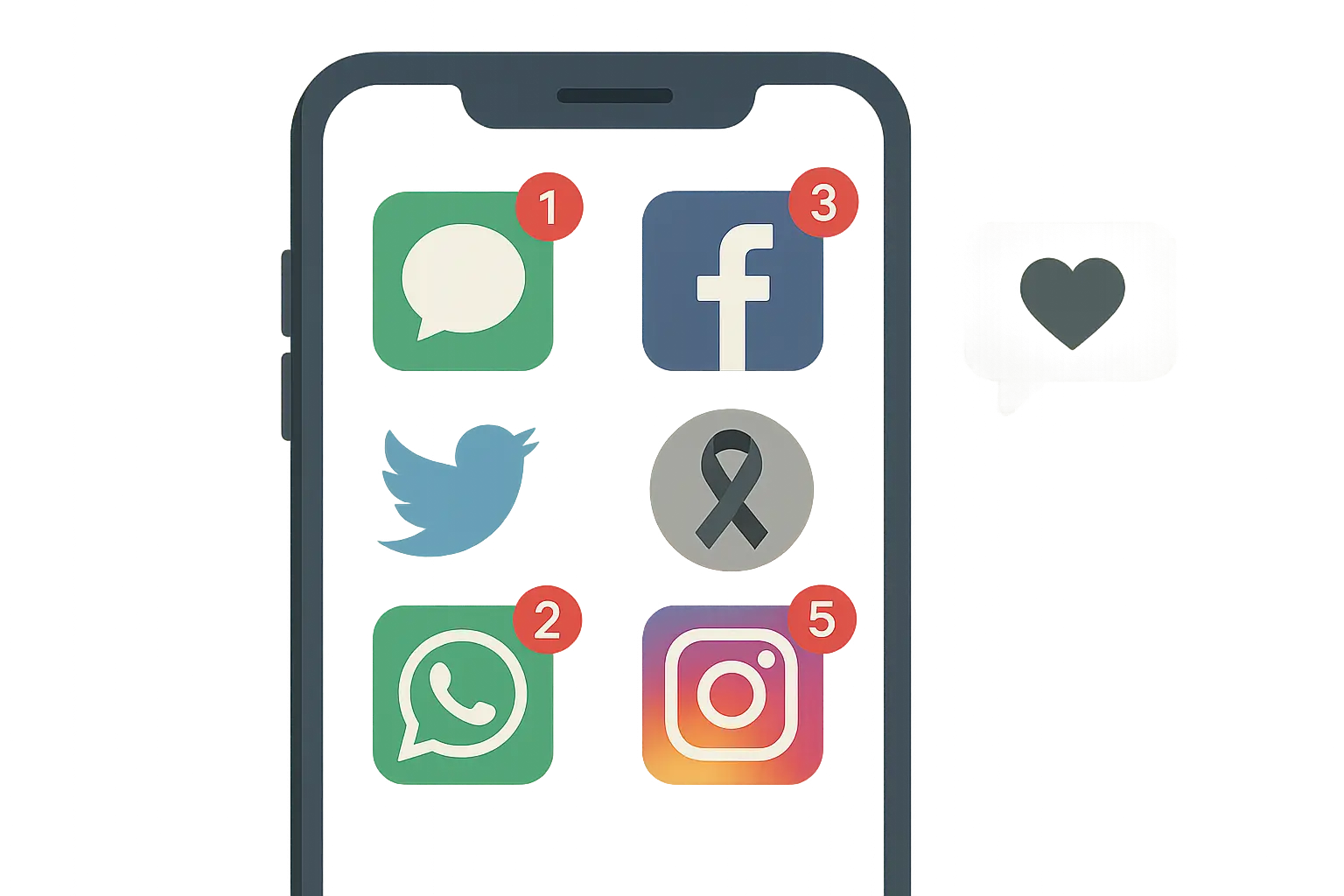
Facebook Comments vs. Private Messages
Public Facebook comments on death announcements can feel supportive – they show the family that many people cared about their loved one. But they can also feel performative, like you’re expressing sympathy for an audience rather than the grieving family.
Private messages usually feel more genuine. They give you space to share longer memories or offer specific help without worrying about public perception. Plus, the family can respond (or not respond) without feeling like they’re being watched.
The power of authentic digital condolences became clear when longtime 7NEWS reporter Byron Barnett passed away. The outpouring of “condolence messages for longtime 7NEWS reporter Byron Barnett” from WHDH viewers showed how personal, specific memories – remembering his persistent questioning of Bill Belichick or his kindness to interns – provided genuine comfort to his family and colleagues.
When Texting Works
Texting sympathy messages felt wrong to me for years – too casual for something so serious. But I’ve realized it depends entirely on your relationship and the circumstances.
If you normally text this person daily, suddenly switching to formal cards might feel distant. A heartfelt text saying “thinking of you today” can provide immediate comfort, especially if you follow up with a card later.
The key is reading the situation. Some people appreciate quick check-ins via text during the chaos of funeral planning. Others need space and prefer less immediate forms of communication.
Say Something Real Instead of Something Safe
The most helpful condolence messages combine four simple elements: acknowledge what happened, share how you feel, mention something specific about the person who died, and offer concrete help. You don’t need to be a professional writer – you just need to be genuine.
I’ve written terrible sympathy messages over the years. The cringe-worthy ones were always when I tried too hard to sound “appropriate” instead of just being human.
The Four Things That Actually Matter
Every meaningful condolence message needs these core pieces: direct acknowledgment of the death, authentic expression of your feelings, specific details about the deceased, and genuine offers of support. These elements work together to create messages that provide real comfort rather than empty platitudes.
| Element | What It Does | Example |
|---|---|---|
| Direct Acknowledgment | Shows you’re not afraid to face their reality | “I was so sad to hear that your mom died” |
| Authentic Emotion | Connects human to human | “I’m devastated by this news” |
| Specific Details | Proves you saw them as an individual | “I’ll never forget her terrible dad jokes at every barbecue” |
| Genuine Support | Offers concrete help without burdening them | “I’m bringing dinner Tuesday at 6 PM” |
Say “Died” Instead of Dancing Around It
“Passed away,” “lost their battle,” “went to sleep” – these phrases might feel gentler, but they often frustrate grieving people who are dealing with the stark reality of death. These euphemisms can make the loss feel minimized or misunderstood.
I’ve learned to say “died” when that’s what happened. It sounds harsh at first, but it acknowledges the magnitude of what the family is experiencing. They’re not dealing with someone who “passed” – they’re dealing with someone who died, and that’s a much bigger, scarier thing.
This doesn’t mean being brutal about it. You can say “I was so sad to hear that your mom died” with gentleness and love. The directness actually shows you’re not afraid to sit with them in their pain.

Share Memories That Actually Mean Something
Bad: “He was a good man who will be missed.”
Better: “He always remembered my kids’ names and asked how they were doing.”
The second version tells the family something they might not have known about their loved one’s impact. It shows you really saw and appreciated this person as an individual, not just as someone’s father or husband.
Don’t worry if your memory seems small or insignificant. Sometimes the tiny moments – how someone always held the door, their terrible dad jokes, the way they hummed while working – these details paint the most vivid pictures of who someone really was.
Just as crafting heartfelt eulogies for brothers requires specific qualities and memories that made the person unique, meaningful condolence messages focus on individual details rather than generic statements.
Discover how to weave personal memories into heartfelt tributes using the Eulogy Generator.
Offers of Help That Don’t Suck
“Let me know if you need anything” is useless. It sounds supportive, but it actually creates more work for grieving people who are already overwhelmed.
Grieving people often can’t think clearly enough to identify what they need, let alone ask for it. They’re exhausted and usually trying to hold it together for everyone else.
Be Specific With Your Help
Instead of “let me know if you need anything,” try:
- “I’m bringing dinner Tuesday around 6 PM – does that work?”
- “I can pick up your kids from school this week if that helps”
- “I’m going to the grocery store tomorrow – can I grab anything for you?”
These offers don’t require decision-making from the grieving family. They just need to say yes or no, which is about all the mental energy most people have during acute grief.
Professional guidance confirms this approach: offering specific help rather than general support shows continuous care, and follow-up messages a few weeks later can help your coworker feel that they are still in your thoughts when the initial wave of support fades.
Get step-by-step guidance for offering real comfort with the Eulogy Generator.
The best help anticipates needs they might not even realize they have yet. Paper plates and napkins, toilet paper, coffee – the mundane stuff that keeps life running when everything feels like it’s falling apart.
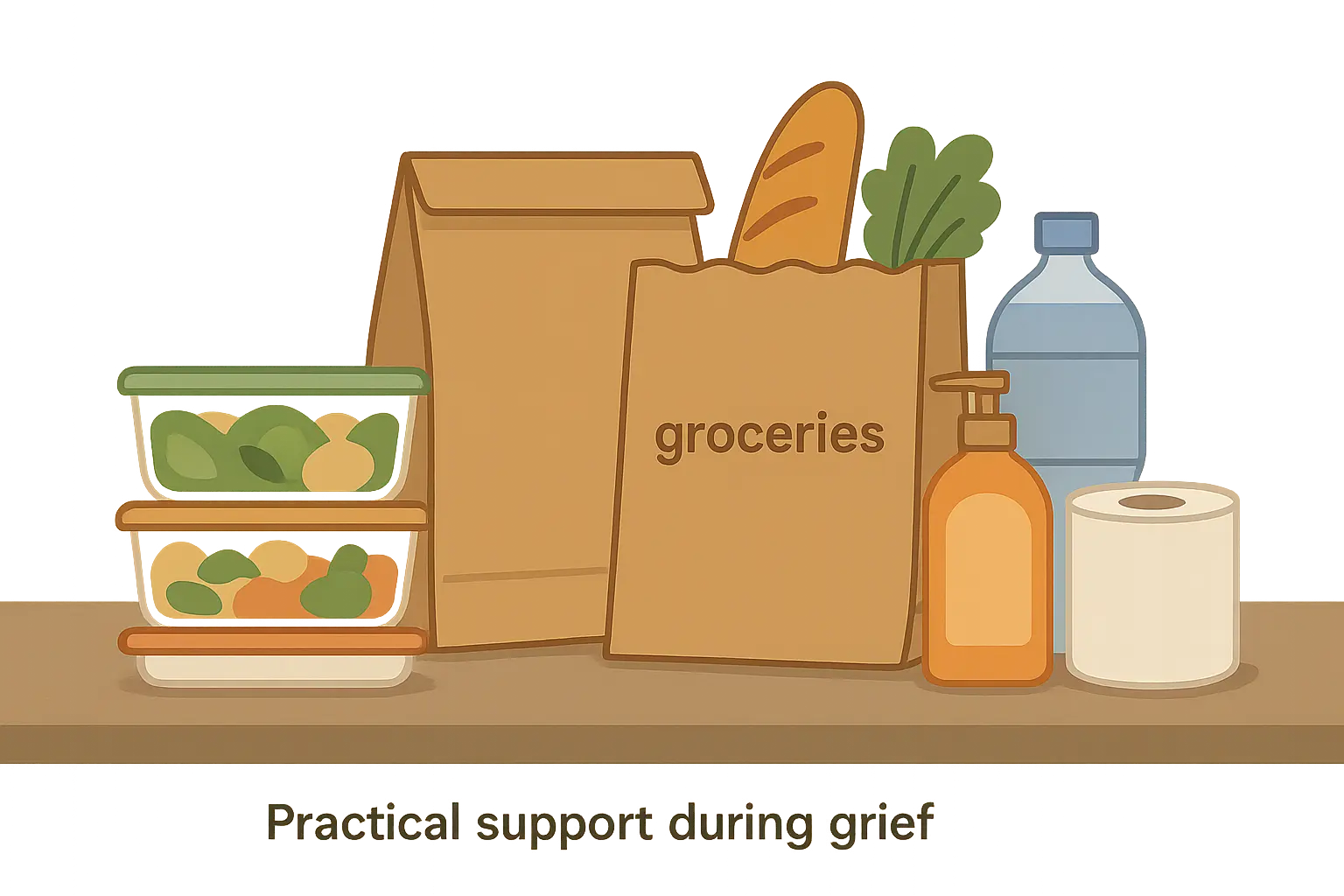
Words That Help vs. Words That Hurt
Certain phrases, while well-intentioned, can make grief worse. Others provide genuine comfort. Understanding the difference helps ensure your message supports rather than burdens the grieving family.
Skip These Phrases Completely
“Everything happens for a reason” – No. Just no. When someone’s child dies or their spouse has a heart attack, they don’t need cosmic explanations. They need acknowledgment that something terrible happened.
“They’re in a better place” assumes everyone shares your religious beliefs and suggests the person should feel better about their loss. Maybe they believe their loved one is suffering, or maybe they don’t believe in an afterlife at all.
“God needed another angel” makes God sound like a kidnapper and minimizes the very real loss the family is experiencing here on earth.
Try These Instead
“I’m so sorry this happened” acknowledges that something bad occurred without trying to make sense of it or minimize it.
“I’m thinking of you” lets them know they’re not alone without requiring any response or action from them.
“[Name] was lucky to have you” or “You were such a good [son/daughter/spouse] to them” validates their relationship and the love they shared.
These phrases don’t try to fix anything or make the grief go away. They just sit with the person in their pain and let them know someone cares.
Here’s a complete message that puts these principles together:
“Sarah, I was heartbroken to hear that Tom died. I keep thinking about that time he spent three hours helping me fix my fence, even though he barely knew me. He had this way of making everyone feel like family. I’m bringing lasagna and salad on Thursday around 5 PM – I’ll just leave it on your porch if you’re not up for visitors. You don’t need to call me back. Just know I’m thinking of you and the kids. Love, Maria”
Match Your Message to Your Relationship
Your connection to the deceased and the grieving family determines everything about your message – from tone and length to content and delivery method. The same words that comfort a close friend might feel inappropriate coming from a distant acquaintance.
Different relationships need different approaches. Here’s how to match your message to your connection:
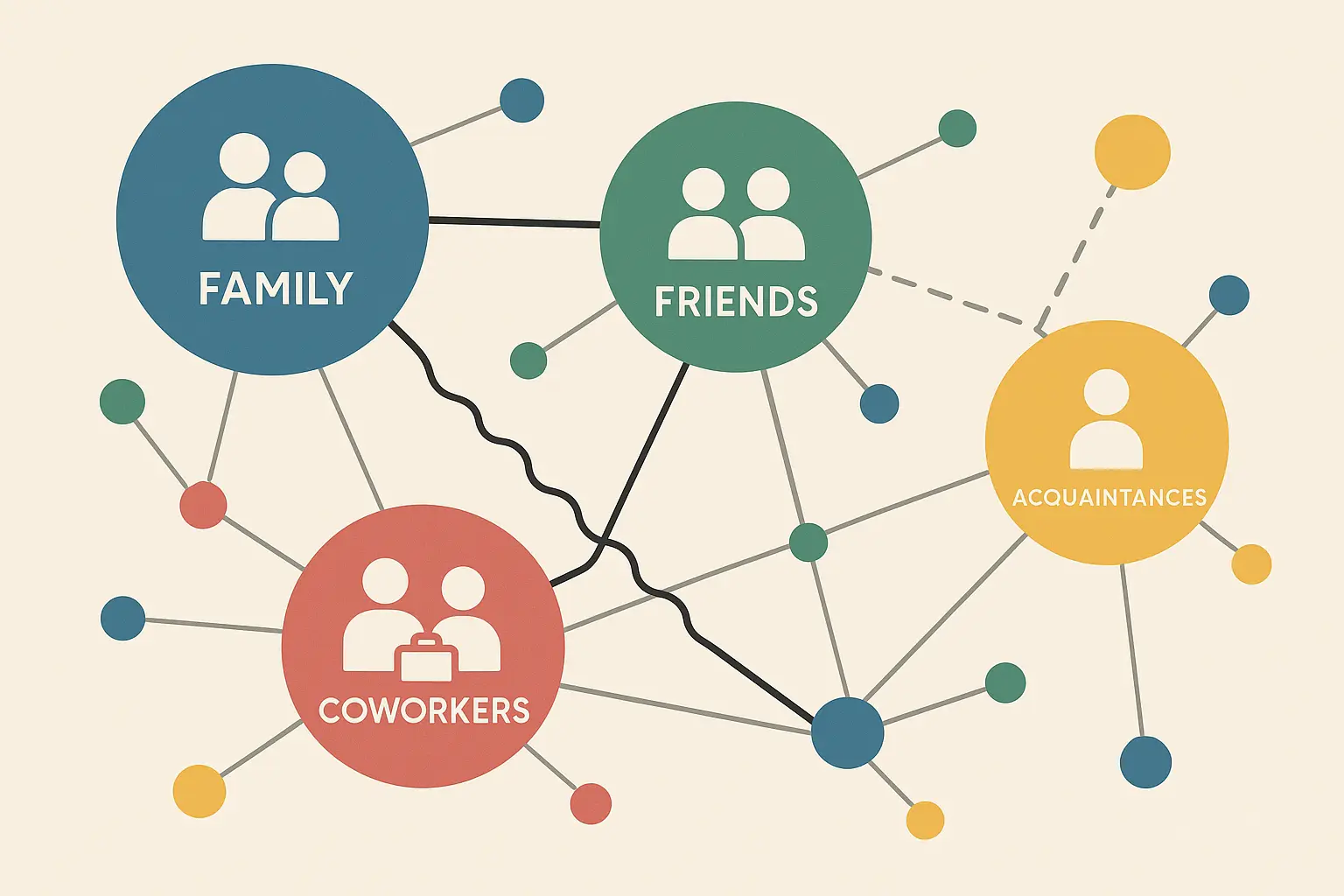
Close Friends and Family: Go Deep
With your inner circle, you don’t have to maintain professional distance or worry about oversharing. You can express raw emotion because your grief is part of their story too.
When You Can Actually Say How You Feel
With close friends and family, you can say “I’m devastated” or “I can’t stop crying” because your grief is connected to theirs. This vulnerability can provide comfort through shared sorrow.
I remember when my best friend’s mom died – someone who’d been a second mother to me. My message was basically me falling apart on paper, sharing how much she’d meant to me and how lost I felt without her. That vulnerability helped my friend feel less alone in her overwhelming grief.
You can share longer stories, multiple memories, and even funny anecdotes that might seem inappropriate coming from someone more distant. Close relationships have context and history that makes almost anything acceptable if it comes from love.
Making Real Commitments
“I’ll be here for whatever you need” means something different when it comes from someone who’s actually going to follow through. Close friends and family can make bigger promises because they have the relationship foundation to keep them.
This might mean committing to regular check-ins, helping with anniversary dates, or being available for middle-of-the-night grief attacks months later. It’s a bigger responsibility, but it’s also where you can make the most meaningful difference.
Coworkers: Keep It Simple But Real
Professional relationships require balance between showing genuine care and maintaining appropriate boundaries. Focus on what you’ve observed at work without claiming intimate knowledge of their personal life.
Mention what you witnessed professionally: “Your dedication to your team was inspiring” or “I always admired how you handled difficult situations with such grace.” These observations show you saw them as more than just a coworker without overstepping.
Keep it shorter than you would for close friends, but don’t make it so brief that it feels dismissive. A few genuine sentences usually hit the right balance between care and professionalism.
Research shows that a person in a bad mood won’t have the patience to read through a long passage, so keeping the message brief and direct while focusing on offering sympathy is especially important in professional settings.
Distant Acquaintances: Brief But Genuine
Sometimes you feel compelled to reach out even when you didn’t know someone well – maybe they were always kind to you, or you just feel moved by their loss. That’s okay, but keep it simple and honest about your relationship.
“I didn’t know [name] well, but they always greeted me with such warmth. I’m sorry for your loss” acknowledges the limited relationship while still expressing genuine care.
Don’t try to manufacture closeness you didn’t have, but don’t let distance stop you from expressing authentic sympathy either.
When Family Dynamics Are Complicated
Not every family relationship is loving and uncomplicated. Sometimes people grieve someone who hurt them, or feel guilty for not grieving enough, or struggle with relief mixed with sadness.
Your message doesn’t need to pretend everything was perfect. You can acknowledge complexity without being specific: “I know your relationship with your dad was complicated, and I’m thinking of you as you navigate all these feelings.”
This validates that grief isn’t always straightforward without requiring them to explain or justify their emotions to you.
Divorced Families and Blended Situations
Divorce and remarriage create complex situations where multiple grieving parties may have different relationships with the deceased. Focus on the specific relationship you’re addressing in each message.
To the ex-wife: “I know you and John shared so many years together and had beautiful children. I’m thinking of you during this difficult time.”
To the current wife: “I saw how much John loved you and how happy you made him. I’m so sorry for your loss.”
Don’t try to manage everyone’s feelings or relationships with each other. Just acknowledge each person’s individual grief

Don’t Step on People’s Beliefs
You don’t need a theology degree to write a decent sympathy note. Just don’t assume everyone believes what you believe.
Religious and cultural considerations require genuine respect and basic research rather than assumptions or avoidance. Getting this wrong can turn your well-intentioned words into sources of additional pain. But getting it right shows deep respect and can provide profound comfort within someone’s faith or cultural framework.
Religious Messages That Don’t Assume
Faith-based condolences can provide deep comfort when they align with the recipient’s beliefs, but they can cause pain when they impose unwanted religious perspectives.
Christian Comfort Without the Preaching
If they’re religious and you know it, feel free to say “praying for you.” Christian condolences work best when they focus on comfort rather than explanation.
“Praying for peace and strength for your family” offers support without trying to make theological sense of the loss.
Scripture can be incredibly comforting – if you know the family finds comfort in it. Verses about God’s love, eternal life, or peace can provide hope. But avoid anything that sounds like you’re explaining why this happened or suggesting they should feel differently about their loss.
“May you find comfort in knowing that [name] is at peace” works better than “God needed another angel in heaven.” The first acknowledges their pain while offering gentle hope; the second minimizes their loss with problematic theology.
Jewish Traditions and Memory
Jewish condolences often focus on memory rather than afterlife concepts. “May their memory be a blessing” (or “zichronam livracha” in Hebrew) honors the deceased’s impact on the world rather than speculating about what comes next.
Understanding sitting shiva helps you offer appropriate support. Instead of “let me know if you need anything,” you might say “I’d like to bring food during shiva – what day works best?” This shows you understand their mourning customs and want to participate respectfully.
Islamic Condolences and Faith
“Inna lillahi wa inna ilayhi raji’un” (We belong to Allah and to Him we return) is a traditional Islamic expression that acknowledges both loss and faith. If you’re not Muslim, you don’t need to use Arabic phrases, but understanding their significance helps you respect the family’s perspective.
Islamic mourning customs often involve community support and specific prayer practices. Offering to help coordinate meals or assist with funeral arrangements shows respect for their traditions while providing practical support.
When Families Aren’t Religious
Not everyone finds comfort in religious concepts, and that’s perfectly valid. Secular condolences focus on the person’s impact, the love they shared, and the memories that will continue.
“[Name]’s kindness touched so many lives” or “The love you shared was beautiful to witness” honors their relationship without invoking religious concepts they might not embrace.
Focus on legacy, memory, and human connection. These universal experiences provide comfort across all belief systems.
| Faith Tradition | Appropriate Phrases | What to Avoid | Practical Support |
|---|---|---|---|
| Christian | “Praying for peace and strength” | “God needed another angel” | Offer to help with church arrangements |
| Jewish | “May their memory be a blessing” | Afterlife speculation | Bring food during shiva |
| Islamic | “My thoughts are with you” | Religious phrases if you’re not Muslim | Help coordinate community meals |
| Secular | “Their legacy lives on” | Any religious references | Focus on practical, immediate needs |
Cultural Sensitivity Without Walking on Eggshells
Culture shapes how people process grief, what kind of support they welcome, and how they prefer to receive condolences. Your message should respect these preferences rather than imposing your cultural norms.
Some cultures encourage open emotional expression during grief, while others value stoic dignity. Your message should match the family’s cultural approach rather than imposing your own style.
If you’re not sure, err on the side of gentle respect. Express your sympathy clearly but don’t assume they want emotional intensity or public displays of grief if that’s not their cultural norm.
The recent global response to Pope Francis’s death showed how different cultures express condolences – from African leaders praising his “legacy of compassion” to European officials noting his “tireless efforts to promote a world that is fairer for all,” demonstrating how cultural backgrounds shape condolence language while maintaining universal respect.
Timing and Customs Matter
Some cultures have specific mourning periods where certain types of contact are welcome while others aren’t. Some prefer immediate community support, while others need family time first.
When in doubt, ask someone closer to the family about appropriate timing and customs. “I want to offer support but want to be respectful of their traditions – what would be most helpful?” shows cultural sensitivity without requiring you to be an expert on every tradition.
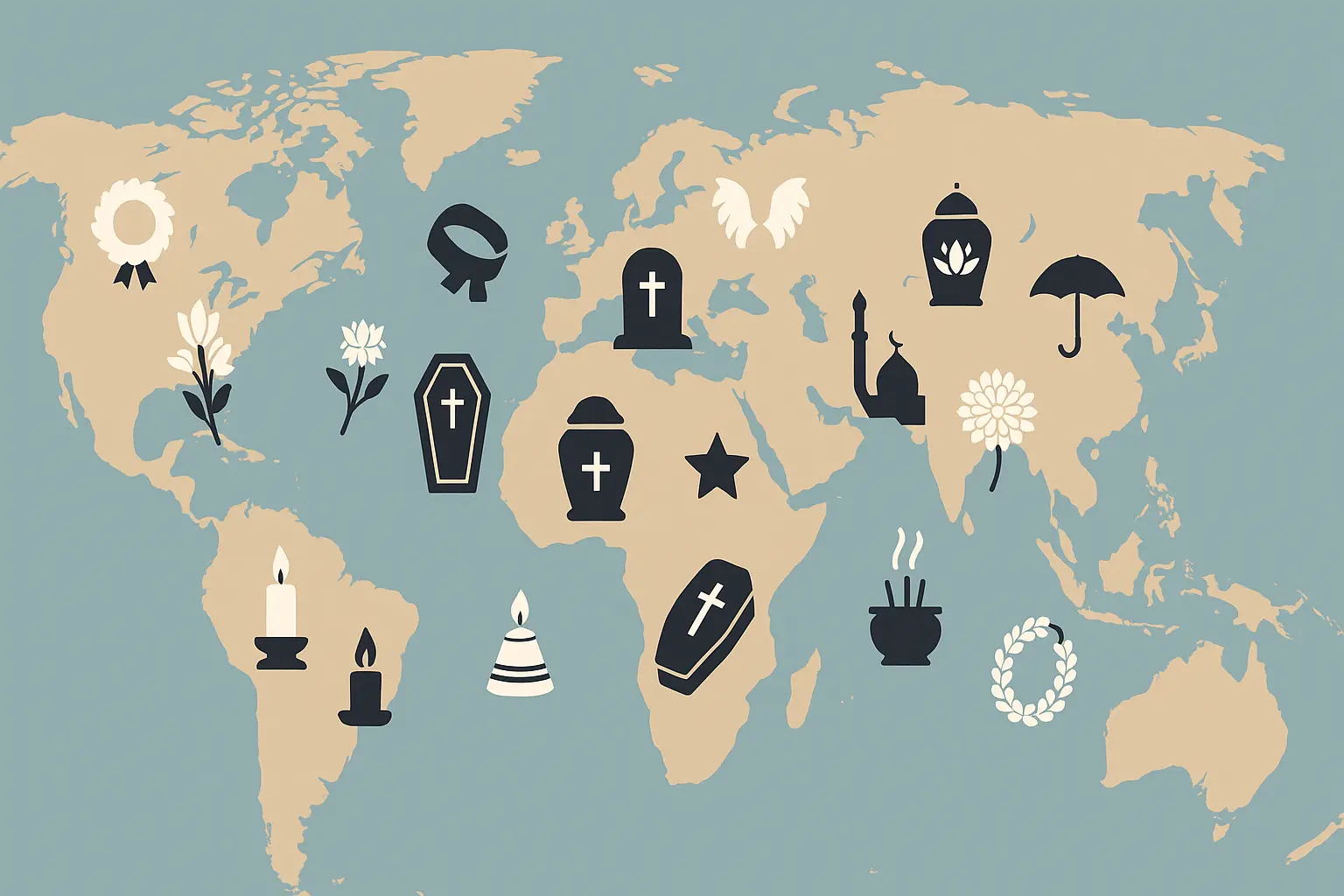
How and When to Actually Send It
The practical aspects of condolence communication – from choosing the right format to timing your message appropriately – often determine whether your thoughtful words actually provide comfort. You can write the most beautiful message in the world, but if you send it at the wrong time or through the wrong channel, it might not provide the comfort you intended.
Choose Your Format Wisely
Different formats serve different purposes and relationships. Understanding when to use each helps ensure your message has maximum impact.
Handwritten Notes Still Matter
Handwritten sympathy cards carry emotional weight that digital messages often lack. These tangible expressions of care can be saved, reread, and treasured as lasting reminders of support during difficult times.
Handwritten notes feel different because they require effort and intention. You can’t dash off a handwritten note while multitasking – it demands your full attention and time.
Grieving people often save these cards and reread them months or years later when they need reminders that people cared. Digital messages get buried in inboxes, but physical cards become keepsakes.
The handwriting itself adds intimacy. Even if your penmanship is terrible, the imperfection shows authenticity that typed text can’t match.
When Digital Works Better
Sometimes digital is more appropriate than traditional cards. If someone posts about their loss on social media, they might appreciate immediate digital support over cards that arrive days later.
Digital messages also work well for sharing photos or longer memories that would be difficult to handwrite. You can include pictures of good times or link to meaningful songs or articles that honor the deceased.
For people who live primarily digital lives, electronic condolences might feel more natural and accessible than physical cards they have to manage during chaos.
The Best of Both Worlds
I’ve found the best approach often combines both: a quick text or email when you first hear the news, followed by a handwritten card within a few days.
The immediate digital message says “I heard and I care right now.” The follow-up card says “I’m still thinking of you and this mattered enough for me to sit down and write.”
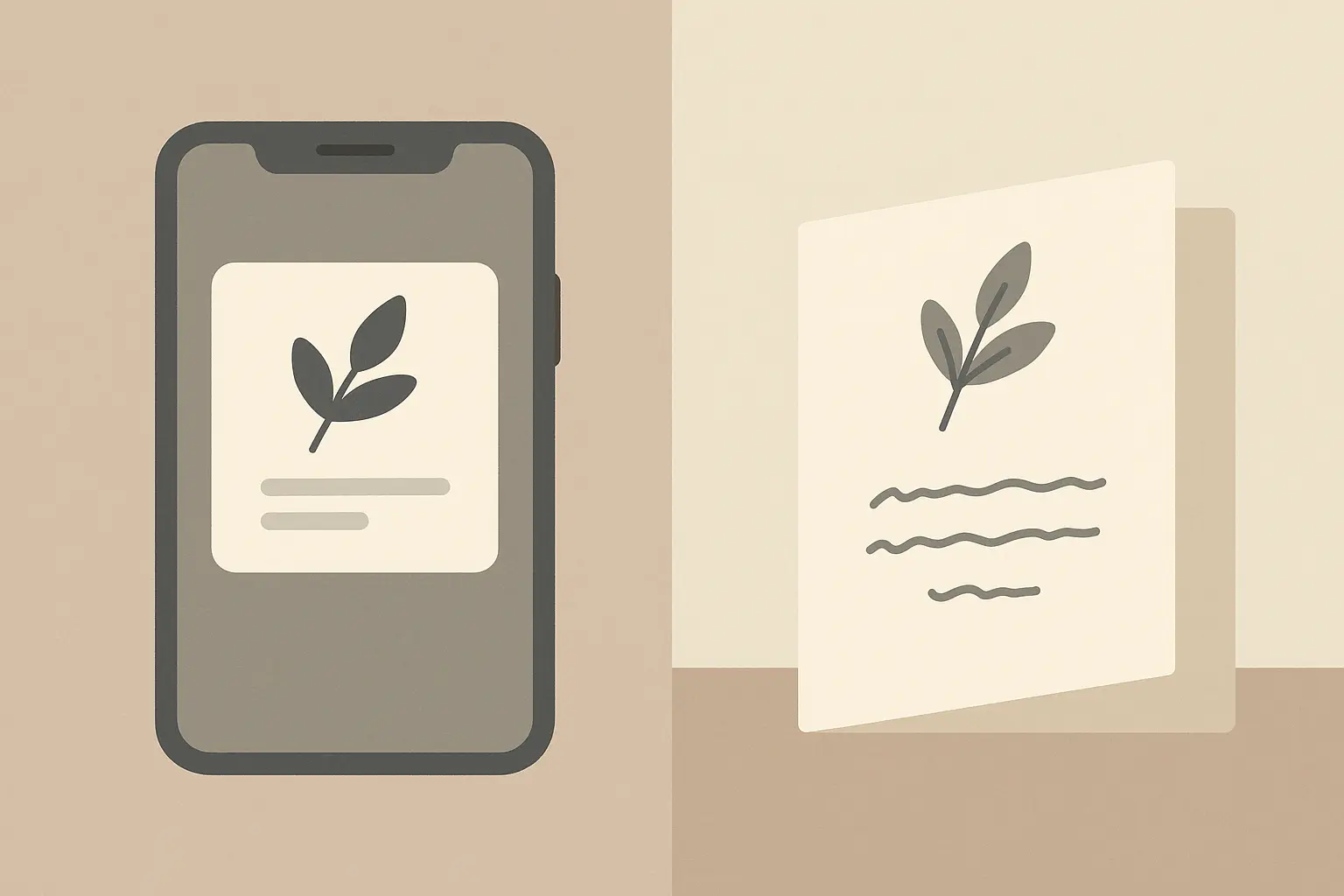
Timing That Actually Helps
Bad timing can turn even the most thoughtful words into additional stress for grieving families. Good timing amplifies the comfort your message provides.
The First 48 Hours: Keep It Brief
The first few days after someone dies are usually overwhelming for the family. Everyone reaches out at once, which can feel both supportive and exhausting.
Keep initial messages brief but genuine during this period. “Thinking of you and sending love” might be more helpful than a long, detailed message they don’t have energy to process.
If you’re close to the family, this is when concrete offers of help matter most. “I’m bringing dinner tomorrow” is more useful than lengthy messages when they’re drowning in funeral arrangements.
When Everyone Else Moves On
The most meaningful messages often come weeks or months after the death, when the initial flood of support has dried up but the grief remains intense.
“I was thinking about your mom today and wanted you to know she’s not forgotten” can mean everything to someone who feels the world has moved on while they’re still struggling.
These messages don’t need to be long or elaborate. Sometimes just “still thinking of you” on a random Tuesday provides more comfort than dozens of cards during the funeral week.
Remember the Hard Dates
Death anniversaries, birthdays, and first holidays without someone are brutal for grieving families. A simple message acknowledging these dates shows incredible thoughtfulness.
“Thinking of you on your dad’s birthday” or “I know Christmas will be hard this year without her” validates their ongoing grief and shows you remember their loved one as a real person, not just a past event.
You don’t need to send elaborate messages on these dates. Just acknowledgment that you remember and care can provide enormous comfort during predictably difficult times.
Here’s how anniversary remembrance looks in practice:
“Hi Janet, I know today marks one year since we lost Michael. I was looking through old photos and found that picture of him teaching the kids to fish at the lake. His patience with those tangled lines was legendary. Just wanted you to know I’m thinking of you and the family today. No need to respond – just sending love. – David”
Following Up Without Being Annoying
Ongoing support requires balance between showing continued care and respecting the grieving person’s need for space and normalcy.
Check-Ins That Don’t Create Work
“How are you doing?” puts pressure on grieving people to summarize their emotional state, which is often impossible and exhausting.
Better check-ins offer something specific: “I’m going to the store – can I grab anything for you?” or “I saw this photo of [name] and it made me smile – thought you might like to see it.”
These approaches show you care without requiring them to manage your concern or provide updates on their grief journey.
When to Step Back Gracefully
Sometimes people need space to grieve privately, and that’s okay. If someone stops responding to your messages or seems overwhelmed by contact, it’s time to step back.
You can do this gracefully: “I don’t want to overwhelm you with messages, but I’m here if you need anything. No need to respond – just know I’m thinking of you.”
This gives them permission to not respond while keeping the door open for future connection when they’re ready.

Before You Send – Quick Checklist:
- ☐ Did you mention their name and that they died?
- ☐ Is there something specific about them as a person?
- ☐ Does your offer of help have a day and time?
- ☐ Would this comfort you, or just make you feel better about yourself?
- ☐ Did you avoid “everything happens for a reason”?
How Eulogy Generator Can Help When Words Feel Impossible
While condolence messages provide immediate comfort to grieving families, eulogies present an even greater challenge – standing before mourners to deliver a comprehensive tribute when you’re overwhelmed by grief yourself.
I’ve been there – staring at a blank page, knowing I need to somehow capture an entire lifetime in a few minutes of speech. How do you distill decades of memories, relationships, and impact into words that will comfort a room full of grieving people when you can barely think straight through your own grief?
Just as there are different types of condolence messages for various relationships and situations, Eulogy Generator understands this overwhelming responsibility and provides guidance for crafting meaningful tributes.
The same elements that make condolence messages effective – personalization, specific memories, and cultural sensitivity – are exactly what eulogies need, but on a much larger scale. The platform guides you through the process with thoughtful questions about your relationship with the deceased, their qualities, and meaningful memories.
Whether you’re looking for funny eulogy examples to honor someone’s sense of humor or need help with more traditional tributes, the interactive approach takes the guesswork out of eulogy writing.
Instead of staring at that terrifying blank page, you’re guided through a conversation about the person you’re honoring. The result is a personalized tribute that captures their unique impact while providing the structure and flow that makes for a meaningful eulogy.
From crafting heartfelt eulogies for dogs to honoring human family members, the goal remains the same: creating words that truly celebrate and remember.
Create words that comfort and honor with the Eulogy Generator.
Whether you’re crafting a simple sympathy message or preparing to deliver a full eulogy, the goal remains the same: honoring a life lived while providing comfort to those who mourn. Try Eulogy Generator today and transform your overwhelming grief into words that truly celebrate and remember.
Begin your meaningful message today with the Eulogy Generator.

Final Thoughts
Look, you’re going to feel awkward no matter what you write. That’s normal – death is awkward. But your discomfort doesn’t matter as much as their grief.
Writing condolence messages will probably never feel easy, and honestly, that’s okay. The discomfort you feel when trying to find the right words shows that you understand the gravity of loss and the importance of getting it right.
I’ve learned that perfect condolence messages don’t exist, but authentic ones do. The grieving person doesn’t need you to have all the answers or say something profound that makes their pain disappear. They need you to acknowledge their loss, share in their sorrow, and remind them that their loved one mattered to others too.
The evolution from formal sympathy expressions to personal, authentic condolences reflects our growing understanding of what grief actually needs: connection, not distance; specificity, not generalities; ongoing support, not one-time gestures.
Send something real, offer something specific, and remember them when everyone else has moved on. That’s it.
These messages we send – whether they’re brief texts or lengthy handwritten letters – become part of someone’s grief story. They’re evidence that their loved one’s life mattered, that their pain is witnessed, and that they’re not alone in their sorrow. That’s a profound responsibility and an incredible gift we can offer each other in our most vulnerable moments.

